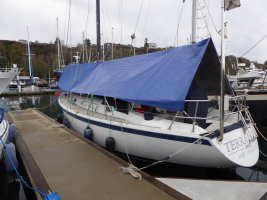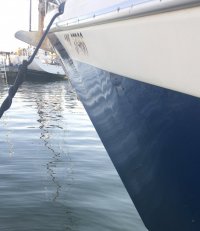It's that time of year when the decks have turned a festive green, especially on the parts that don't get even a glimmer of sunshine, yet it's too cold and rainy to put on my shorts and go give the boat a nice scrub.
The past several years, cleaning off the green and making Makana pretty again has been a multi-stage process. A good top-to-bottom scrub with boat-soap, then hands and knees with a scrub-brush and detergent to get the most stubborn spots, then detail cleaning (the edges of the rub-rail and under the "tee" part of each track seem to get particularly gross).
It takes a couple of days before I feel good about letting people see her.
This year, I'm thinking of bringing the home power-washer into play. Not on the blast-the-pebbles-out-of-the-driveway-concrete setting, but on some gentler setting. With the hope of getting rid of the green without losing any gelcoat, or non-skid, or paint, or destroying the bedding under fittings.
Anyone power-wash their decks and have tips for success?
Bruce
The past several years, cleaning off the green and making Makana pretty again has been a multi-stage process. A good top-to-bottom scrub with boat-soap, then hands and knees with a scrub-brush and detergent to get the most stubborn spots, then detail cleaning (the edges of the rub-rail and under the "tee" part of each track seem to get particularly gross).
It takes a couple of days before I feel good about letting people see her.
This year, I'm thinking of bringing the home power-washer into play. Not on the blast-the-pebbles-out-of-the-driveway-concrete setting, but on some gentler setting. With the hope of getting rid of the green without losing any gelcoat, or non-skid, or paint, or destroying the bedding under fittings.
Anyone power-wash their decks and have tips for success?
Bruce
Last edited:


